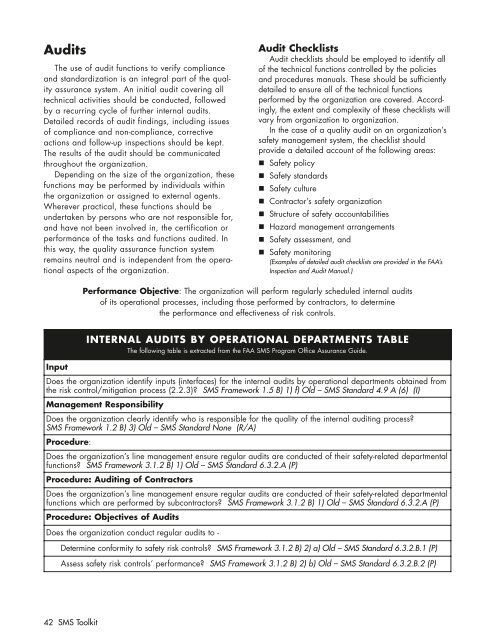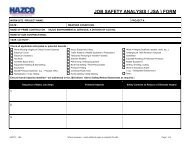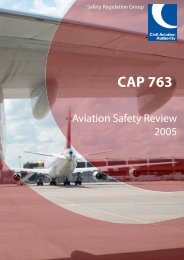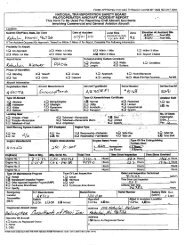International Helicopter Safety Team Safety Management System Toolkit
IHST - Safety Management Toolkit - Skybrary
IHST - Safety Management Toolkit - Skybrary
- No tags were found...
You also want an ePaper? Increase the reach of your titles
YUMPU automatically turns print PDFs into web optimized ePapers that Google loves.
Audits<br />
The use of audit functions to verify compliance<br />
and standardization is an integral part of the quality<br />
assurance system. An initial audit covering all<br />
technical activities should be conducted, followed<br />
by a recurring cycle of further internal audits.<br />
Detailed records of audit findings, including issues<br />
of compliance and non-compliance, corrective<br />
actions and follow-up inspections should be kept.<br />
The results of the audit should be communicated<br />
throughout the organization.<br />
Depending on the size of the organization, these<br />
functions may be performed by individuals within<br />
the organization or assigned to external agents.<br />
Wherever practical, these functions should be<br />
undertaken by persons who are not responsible for,<br />
and have not been involved in, the certification or<br />
performance of the tasks and functions audited. In<br />
this way, the quality assurance function system<br />
remains neutral and is independent from the operational<br />
aspects of the organization.<br />
Audit Checklists<br />
Audit checklists should be employed to identify all<br />
of the technical functions controlled by the policies<br />
and procedures manuals. These should be sufficiently<br />
detailed to ensure all of the technical functions<br />
performed by the organization are covered. Accordingly,<br />
the extent and complexity of these checklists will<br />
vary from organization to organization.<br />
In the case of a quality audit on an organization’s<br />
safety management system, the checklist should<br />
provide a detailed account of the following areas:<br />
<strong>Safety</strong> policy<br />
<strong>Safety</strong> standards<br />
<strong>Safety</strong> culture<br />
Contractor’s safety organization<br />
Structure of safety accountabilities<br />
Hazard management arrangements<br />
<strong>Safety</strong> assessment, and<br />
<strong>Safety</strong> monitoring<br />
(Examples of detailed audit checklists are provided in the FAA’s<br />
Inspection and Audit Manual.)<br />
Performance Objective: The organization will perform regularly scheduled internal audits<br />
of its operational processes, including those performed by contractors, to determine<br />
the performance and effectiveness of risk controls.<br />
INTERNAL AUDITS BY OPERATIONAL DEPARTMENTS TABLE<br />
The following table is extracted from the FAA SMS Program Office Assurance Guide.<br />
Input<br />
Does the organization identify inputs (interfaces) for the internal audits by operational departments obtained from<br />
the risk control/mitigation process (2.2.3)? SMS Framework 1.5 B) 1) f) Old – SMS Standard 4.9 A (6) (I)<br />
<strong>Management</strong> Responsibility<br />
Does the organization clearly identify who is responsible for the quality of the internal auditing process?<br />
SMS Framework 1.2 B) 3) Old – SMS Standard None (R/A)<br />
Procedure:<br />
Does the organization’s line management ensure regular audits are conducted of their safety-related departmental<br />
functions? SMS Framework 3.1.2 B) 1) Old – SMS Standard 6.3.2.A (P)<br />
Procedure: Auditing of Contractors<br />
Does the organization’s line management ensure regular audits are conducted of their safety-related departmental<br />
functions which are performed by subcontractors? SMS Framework 3.1.2 B) 1) Old – SMS Standard 6.3.2.A (P)<br />
Procedure: Objectives of Audits<br />
Does the organization conduct regular audits to -<br />
Determine conformity to safety risk controls? SMS Framework 3.1.2 B) 2) a) Old – SMS Standard 6.3.2.B.1 (P)<br />
Assess safety risk controls’ performance? SMS Framework 3.1.2 B) 2) b) Old – SMS Standard 6.3.2.B.2 (P)<br />
42 SMS <strong>Toolkit</strong>







